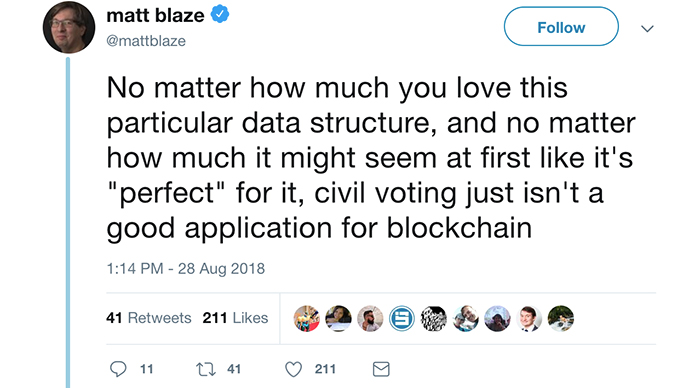Blockchain Technology Explained: The Biggest Use Cases for State and Local Government
Along with artificial intelligence and the Internet of Things, blockchain is one of a handful of technologies that might have more buzz around it than actual deployments across state and local governments.
Blockchain technology, in and of itself, cannot replace legacy systems for databases, record keeping or transaction management, but it can enhance such systems, experts say. Blockchain voting is also getting more attention, though cybersecurity experts are skeptical about it and it has not been tried in the United States on a large scale yet.
Most state government officials are still in a wait-and-see mode about the technology, though blockchain use cases continue to proliferate. According to a 2017 National Association of State CIOs report, 63 percent of those surveyed were still investigating blockchain in state government with informal discussions, 26 percent said there were no discussions of blockchain at that time and 5 percent had adopted blockchain technology in support of some state government services.
Mark Fisk, a partner at IBM Global Services Public Sector who specializes in blockchain, says state and local government leaders should begin to think about blockchain by considering their business networks and the challenges they experience in them as they work toward common goals.
“Where blockchain comes in is, if those challenges involve trust, transparency, accountability and visibility, that is where we talk about how a blockchain capability can help address some of those challenges,” he says.
As opposed to one member of a business network being the one that verifies transactions and serves as a source of truth, blockchain enables the entire business network to do so.
If government agencies have tried traditional mechanisms for standing up centralized capabilities, or for collaborating and sharing information, and they still have challenges, blockchain technology can help, Fisk notes.
MORE FROM STATETECH: These are the top state and local government IT trends to watch in 2019.
What Is Blockchain Technology?
Blockchain technology, the NASCIO report notes, “fits into the enterprise as a new and growing capability for creating, recording, and verifying transactions instantaneously using a decentralized autonomous logic.”
No central authority is required to authorize, verify or approve a transaction. Instead, blockchain serves as “a shared, global, incorruptible and therefore trusted ledger of economic transactions. It is controlled equally by all who wish to participate and transparent, yet private.”
A blockchain is a steadily growing count of “blocks” that create an immutable record where each block is “chained” or linked to the previous block using state of the art cryptography, NASCIO notes. Each entry in the blockchain is recorded and then validated and reconciled by all participants in the network to ensure its consistent integrity.
“Blockchain technology can be programmed to record not just financial transactions, but nearly anything that holds value and can be expressed in code,” NASCIO notes. “Anything from birth, death and marriage licenses, to property deeds and titles of ownership, educational certificates, financial accounts, medical procedures, insurance claims, to votes, the possibilities are truly limitless.”
The public sector is interested in using blockchain for selective data sharing, say between different government agencies or organizations, Fisk says, in a way that allows them to get visibility into not just the information but the rules that go with the information. State and local government agencies are also turning to blockchain for added data security — “protected from the outside, privacy from the inside,” Fisk says.
State and local government agencies often have a need to regulate and audit, Fisk adds, so blockchain provides them with a way to do that, but in a way that the business network members agree on.
GET STARTED: Register for the StateTech Insider program today.
How to Set Up a Blockchain for Government
Once a government agency decides it wants to use a blockchain, it needs to define the rules and roles of the blockchain, what data is going to be added to the ledger and what the security policies are going to be, and what counts as a valid transaction on the blockchain networks, Fisk says
Most blockchains are built on the Hyperledger Fabric, an open-source blockchain framework implementation, which enables those aspects through a permissioned blockchain. Users access their nodes on the blockchain through a REST application programming interface, and users may access a common application or use an API to access a legacy system or to feed an analytics warehouse. Coding the blockchain rules is relatively simple and can be done in JavaScript, and once the ledger is defined, interacting with the blockchain is as simple as interacting with a REST API, Fisk says.
IBM has a cloud-hosted solution for the Hyperledger Fabric, as do other firms, such as Oracle and Microsoft with its Azure platform.
Once an agency is partnering with a vendor that uses the fabric to build the blockchain, that is “half the battle,” according to Fisk. The other half of the battle is how the agency will use it.
Agencies may use blockchain to feed existing processes and systems and make them more transparent. Often, though, agencies use blockchain for new capabilities, and new data sets they did not previously use, such as sensor data from IoT sensors. Or it can be used to create web portals or applications that give users greater visibility into data, without the user ever even knowing it is a blockchain supporting the app.
“It’s a journey of where you’re trying to go,” Fisk says. “But once you get a blockchain up and running, you have this better, more trusted information. You are probably doing some digital reinvention or business process change because you now have the ability to do so.”
State and local governments that want to use blockchain to replace legacy systems are going down the wrong path, Fisk says. Instead, they should focus on what their business network challenges are, the capabilities they cannot implement and whether they can use blockchain technology to enhance or complement existing systems.
That requires having an IT leader that sponsors the blockchain, as well as buy-in from agency leaders. Then, agencies should conduct pilot projects to demonstrate the value of the technology, Fisk says.
MORE FROM STATETECH: Discover the drivers of technology innovation in government.
Blockchain Technology Use Cases for State and Local Government
There are numerous blockchain technology use cases, and many state governments are pursuing blockchain initiatives. In 2018, a total of 18 states introduced some form of legislation related to blockchain technology and nine bills became law, according to a tally from the National Conference of State Legislatures.
For example, Colorado’s Department of State is now required to consider research, development, and implementation for encryption and data integrity techniques, including distributed ledger technologies such as blockchain. A law in Tennessee now recognizes the legal authority to use blockchain technology and smart contracts in conducting electronic transactions.
And a Wyoming law authorizes corporations to use electronic networks or databases for the creation or maintenance of corporate records.
The NASCIO report notes that early applications of blockchain technology are “circumstances involving audit; audit trail; necessary record of information lineage; multiple systems or databases that must be reconciled due to recording errors; managing physical or digital assets; managing ownership; managing contracts or agreements involving many secondary parties.”
Blockchain can help state and local government agencies encode and confirm or transfer property; in the transfer of currency, stock, private equity, bonds, derivatives; facilitate crowdfunding; manage the lineage of land titles, vehicle registries, business licenses, passports, voter IDs, death certificates, and proof of insurance; manage and execute contracts, signatures, wills, trusts, and escrows; and serve as a secure way to provide physical asset keys that manage access to homes, hotel rooms, rental cars or private cars.
MORE FROM STATETECH: Find out how state and local government can rethink IT acquisition.
Blockchain Technology for Voting: Can It Be Secured?
Another use case for blockchain is in elections and voting. Advocates argue that blockchain can also enable secure, real-time representation with decentralized voting.
This past election season, the state of West Virginia implemented a blockchain-based voting app for the first time. Secretary of State Mac Warner reported that in the 2018 midterm elections, 144 military personnel stationed overseas from 24 counties were able to cast their ballots on a mobile, blockchain-based platform called Voatz.
Here is how it works, per the Washington Post:
To cast a ballot, voters must first register through the app by uploading an image of their driver’s license or other photo identification. Then the app instructs them to submit a short video of their own face. Facial recognition technology supplied by a voter’s iPhone or Android device matches the video against the photo ID, and the personal information on the ID is matched to West Virginia’s voter registration database. Once the verification is complete, voters can make their selections and confirm their ballot by fingerprint or facial recognition.
However, Michael Queen, deputy chief of staff to Warner, said West Virginia has no plans to extend the use of the app. “Secretary Warner has never and will never advocate that this is a solution for mainstream voting,” Queen told the Post.
Maurice Turner, an election security expert at the Center for Democracy and Technology, tells the Post the blockchain system is likely more secure than sending in an absentee ballot via email, and uses facial recognition technology. However, he says it is still far less secure than submitting a paper ballot in person.

Johns Hopkins University cryptography professor Matthew Green has numerous concerns about blockchain voting technology, and a key one is that the technology relies on computer hardware and software that could potentially be compromised.
“Protecting connected devices against hacking is hard enough, and, even if that could be achieved, developing an online system that preserves all the attributes we expect from democratic elections would be incredibly difficult to pull off,” MIT Technology Review reports.
“No matter how much it might seem at first like it's ‘perfect’ for it, civil voting just isn't a good application for blockchain," tweeted Matt Blaze, a University of Pennsylvania computer science and cryptography professor and expert on electronic voting security.










